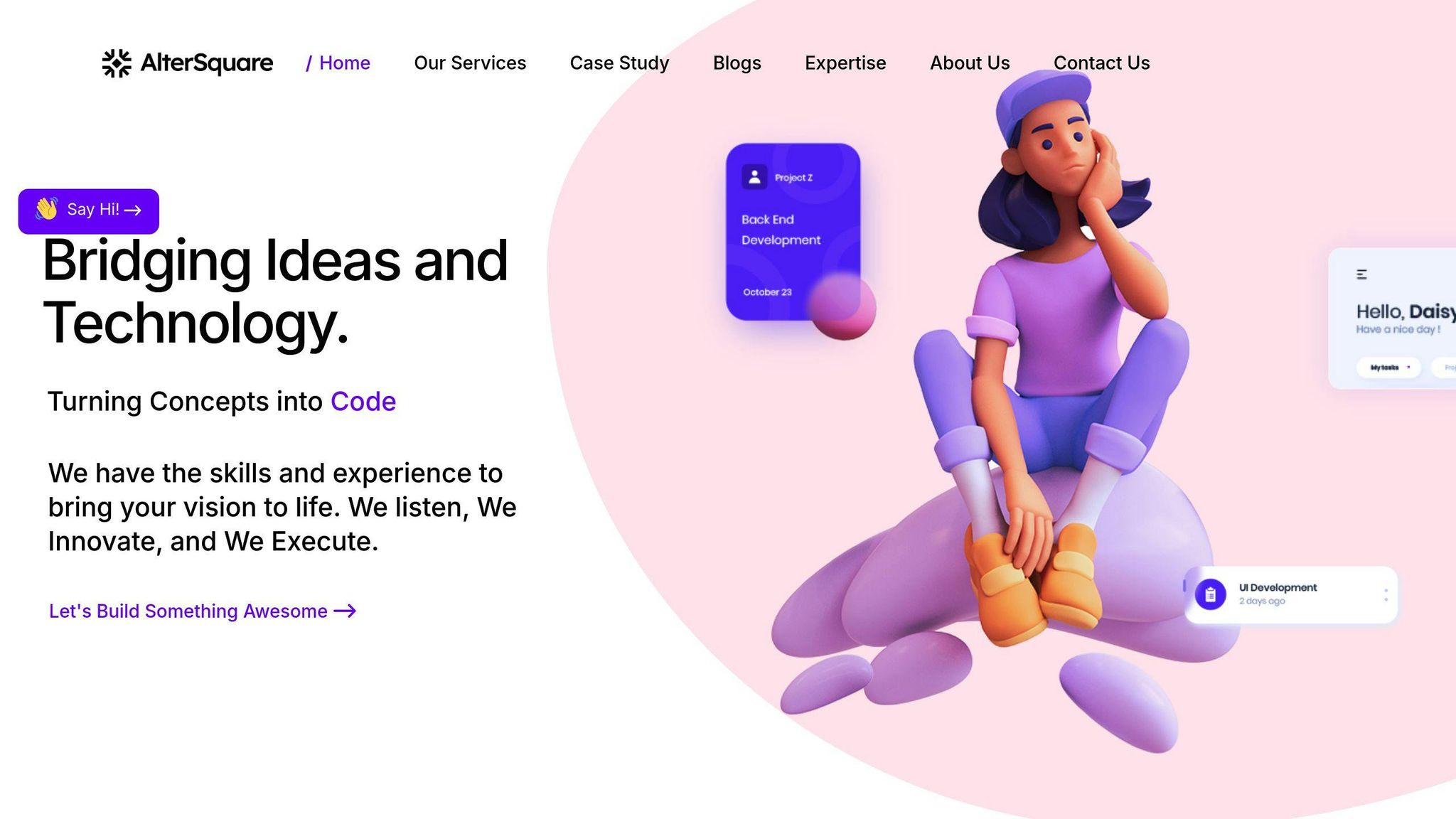10 Common Pitfalls in MVP Development and How Agile Processes Solve Them
Taher Pardawala January 24, 2025
Building an MVP (Minimum Viable Product) is tricky. Many startups fail because they overcomplicate, skip market research, or ignore user feedback. Agile processes, with their iterative and user-focused approach, can help avoid these mistakes.
Key MVP pitfalls include:
- Excessive complexity: Adding too many features upfront.
- Ignoring user feedback: Missing opportunities to refine based on real needs.
- Unclear goals: Losing focus without clear objectives.
- Skipping market research: Misjudging demand and user behavior.
- Poor resource allocation: Wasting time and money on unnecessary elements.
- Insufficient testing: Leading to product failures at launch.
- Inflexible processes: Struggling to adapt to changes.
- Neglecting scalability: Failing to plan for growth.
- Lack of collaboration: Miscommunication within teams.
- Overlooking user experience: Delivering a product that frustrates users.
How Agile helps: Agile emphasizes small, manageable steps, constant user feedback, and adaptability. It ensures MVPs are lean, well-tested, and aligned with market needs. Companies like Dropbox and Slack have used these principles to achieve massive success.
MVP Development Pitfalls and Agile Solutions
1. Excessive MVP Complexity
Feature overload is a common trap in MVP development. Picture a food delivery app trying to include user reviews, multiple payment options, and loyalty programs before even confirming basic ordering works. This approach wastes resources and delays getting to market.
Agile methodology counters this with focused sprint planning and user stories, keeping teams laser-focused on delivering core value.
2. Ignoring User Feedback
Quibi‘s $1.75 billion failure is a classic example of ignoring what users actually want – like their demand for TV casting functionality.
Agile thrives on feedback loops. Look at Slack: their relentless focus on refining the platform based on user input turned them into a $27.7 billion company by 2020.
3. Unclear Goals
Without clear goals, teams lose focus. Twitter’s early version, Twttr, succeeded because it stuck to one simple objective: enabling SMS-based status updates. This clarity kept them on track.
Agile ensures clarity with tools like:
- Product Vision: For long-term focus
- Sprint Goals: For short-term, measurable progress
- Definition of Done: To set quality standards
4. Skipping Market Research
Webvan burned through $800 million because they didn’t understand online grocery shopping habits. In contrast, Amazon writes press releases for potential products before development, ensuring alignment with market needs.
5. Poor Resource Allocation
Juicero spent $120 million on a juicer that manual squeezing could outperform. Agile minimizes this risk with time-boxed sprints and regular resource reviews.
6. Insufficient Testing
Remember the 2013 Healthcare.gov crash? It’s the opposite of Google’s approach, where they run 150 million automated tests daily. Agile’s continuous integration approach avoids such catastrophic failures.
7. Inflexible Development Process
Kodak’s downfall in the face of digital photography shows how rigidity can sink even major players. Agile embraces adaptability with regular sprint reviews and retrospectives. Zappos is a great example, pivoting their business model quickly based on market needs.
8. Neglecting Scalability
Twitter’s infamous early crashes (hello, “Fail Whale”) highlight the dangers of ignoring scalability. By contrast, Netflix’s move to cloud-based infrastructure shows how Agile principles can help you plan for growth from the start.
9. Lack of Team Collaboration
The FBI’s Virtual Case File system failed, costing $170 million, partly due to poor team communication. Agile tools like daily stand-ups and cross-functional teams address this. Spotify’s squad model is a shining example of strong collaboration in action.
10. Overlooking User Experience
Apple Maps’ rocky 2012 launch shows what happens when UX takes a backseat. On the flip side, Airbnb’s user-focused approach – constantly improving based on behavior and feedback – has driven their success. Agile embeds UX validation into every step with tools like user stories and sprint-based design reviews.
How to Build An MVP
Agile Methodologies and Business Success
Agile methodologies have been shown to significantly improve project outcomes. According to the Standish Group, they triple project success rates. Deloitte’s research highlights that organizations fully adopting Agile experience 2.7x faster growth and 3x stronger industry leadership. These benefits directly address common MVP challenges like unclear goals and poor resource allocation, turning them into structured sprints and time-boxed deliveries.
Take ING Bank, for example. By implementing Agile, they reduced their time-to-market by 30%. Siemens Health Services saw even greater benefits, doubling productivity while cutting costs [4]. For MVP development, Agile’s approach helps tackle frequent issues like feature creep (Pitfall #1) and scalability oversights (Pitfall #8).
Agile vs. Traditional: Key Metrics
Agile consistently delivers better results compared to traditional methods across several critical business metrics:
| Business Metric | Traditional Approach | Agile Results |
|---|---|---|
| On-time Delivery | 55% | 77% |
| Budget Compliance | 56% | 78% |
| Customer Satisfaction | 3.2/5 | 4.4/5 |
In the context of MVPs, Agile’s adaptability addresses rigid development processes (Pitfall #7) and supports ongoing market validation (Pitfall #2).
Tracking Agile Metrics for MVP Success
To ensure success, MVP teams should monitor key Agile metrics such as:
- Cycle Time: Measures the speed from idea to delivery.
- Lead Time: Tracks how quickly customer requests are fulfilled.
- Sprint Velocity: Gauges team productivity during sprints.
- Customer Satisfaction: Keeps a pulse on user happiness.
- Employee Engagement: Reflects team morale and motivation.
sbb-itb-51b9a02
AlterSquare‘s Approach to MVP Development

AlterSquare applies Agile principles through its I.D.E.A.L Delivery Framework, a method tailored to meet the needs of startups. This framework includes five key phases: Ideation, Design, Execution, Adaptation, and Launch. By following this structured approach, startups can avoid common pitfalls that often lead to MVP failure while focusing on creating scalable, user-first products.
90-Day MVP Development
AlterSquare’s MVP development process is designed to deliver results in just 90 days. Here’s how the timeline breaks down:
| Sprint Phase | Deliverables & Focus |
|---|---|
| Sprint 1 (Days 1-30) | Core functionality, concept validation, validated architecture |
| Sprint 2 (Days 31-60) | Working prototype, user feedback, UI adjustments |
| Sprint 3 (Days 61-90) | Production-ready MVP, final deployment prep |
For example, a fintech startup using this process achieved a 99.9% uptime from day one. Their daily release cycle allowed them to act on early user feedback quickly, aligning with the user-focused principles highlighted in Pitfall #2. This approach also tackled testing issues noted in Pitfall #6.
Scalability and Modernization for Growth
To handle scalability challenges (as noted in Pitfall #8), AlterSquare uses a modernization strategy that ensures smooth transitions while maintaining business operations. Here’s how it works:
1. Microservices Architecture Implementation
- A B2B SaaS client successfully scaled from 10,000 to 100,000 users without any performance issues.
2. Phased Migration Strategy
- An e-commerce platform was upgraded with less than 5 minutes of downtime, thanks to blue-green deployments.
Key Metrics to Watch:
- User adoption rates
- Performance metrics
- Customer feedback
- Usage patterns
- Cost per acquisition
One recent e-commerce MVP project saw a 20% user adoption rate in the first month, showcasing the success of integrating user feedback – a principle tied back to Pitfall #2. This data-driven approach ensures that startups can grow efficiently while maintaining a seamless user experience.
Conclusion: Avoiding Pitfalls with Agile for Successful MVPs
Using Agile’s iterative approach, teams can tackle common challenges and create MVPs that not only test ideas but also set the stage for future growth. The examples discussed highlight how Agile helps refine MVPs into products ready for the market.
The secret to effective MVP development is finding the right balance between speed and quality. Agile practices help reduce risks while building a strong foundation for growth. The I.D.E.A.L Delivery Framework offers a structured way to turn potential challenges into actionable solutions.
Agile helps businesses improve key metrics by focusing on:
- Quick market testing
- Ongoing integration of user feedback
- Smart use of resources
- Early and thorough testing (starting from Sprint 3)
- Planning for scalable systems
By embracing Agile’s emphasis on flexibility and user-driven insights, teams can transform risks into opportunities. Working with experienced Agile professionals can help startups avoid common mistakes and build products that are ready to grow. Agile isn’t just a process – it’s a mindset that helps teams navigate MVP challenges effectively.
These strategies set startups up to turn their MVPs into fully developed products with lasting market impact.
FAQs
What is one common risk when developing an MVP?
One major risk in developing a Minimum Viable Product (MVP) is over-engineering beyond its core purpose. CB Insights highlights that 42% of startups fail because there’s no market need for their product, often due to focusing on overly complex solutions instead of validating basic assumptions first [1].
A simple way to avoid this pitfall is by using approaches like the video demo validation method (discussed earlier). This shows how you can test ideas effectively before diving into full-scale development [3].
Here are a few strategies to help avoid this risk:
- Focus on solving one clear problem.
- Use prototypes to test your ideas.
- Start validating your concept during the early development stages.
These steps align with Agile’s principle of learning through small, iterative deliveries [2].








Leave a Reply